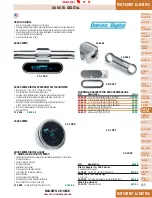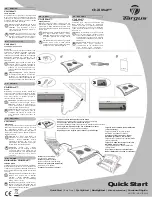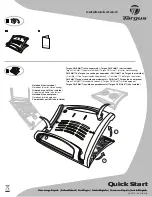
5
3D Features
Circular-polarizer 3D system
The LMD-4251TD and LMD-2451TD incorporate a micropolarizer filter attached to the
LCD panel. Wearing Sony’s BKM-30G or BKM-31G 3D glasses, users experience smooth,
uninterrupted viewing of multiple monitors and flicker-free 3D images. This image
quality helps users to engage in 3D production operations with minimal stress.
Unique lightweight circular-polarizer 3D glasses
Sony provides two types of 3D glasses: the standard BKM-30G, and the clip-on
BKM-31G. These 3D glasses are extremely lightweight*
1
and comfortable to wear.
Designed with a soft frame and center-support structure, BKM-30G glasses fit any size
and shape of head and face, so the wearer experiences minimal stress even during
continuous production tasks. Both the BKM-30G and BKM-31G block approximately
99% of the sun’s ultraviolet rays.*
2
*1 BKM-30G glasses weigh approx. 18 g; BKM-31G glasses weigh approx. 16 g.
*2 These circular-polarizer glasses cannot be used as sunglasses. The blocked spectral range is 280 nm to 380 nm.
BKM-30G
BKM-31G
* Clip-on BKM-31G glasses are worn with the user’s own corrective glasses
*
Multiple 3D input signal formats and interfaces
The LMD-4251TD and LMD-2451TD accept a variety of 3D signal formats including
3G-SDI, Dual-stream HD-SDI, HD-SDI side-by-side, HD-SDI Line interleave (line-by-line),
HD-SDI Field sequential using an optional BKM-250TG 3G-SDI input adaptor, and DVI Line
interleave (line-by-line). This input flexibility enables versatile 3D production both in the
studio and the field.
Disparity simulation
Either the left or right signal phase (or both
phases) of a 3D image can be shifted
horizontally.
L
R
R
R
Original parallax
Weaker parallax
Simulation
Stronger parallax
Shift
Shift
L
L
Variety of 3D/2D display functions
These capabilities are assignable to function keys on the front panel of the LMD-4251TD
and LMD-2451TD, and can also be assigned to an external remote control unit.
*1 These functions work when the optional BKM-250TG 3G-SDI input adaptor is installed. Some features are
unavailable depending on input signals or display modes. Multiple functions may not be used simultaneously.
*2 The 1920 x 1080 image displays with black bands at the top and bottom of the LMD-2451TD WUXGA screen.
Vertical lines
Examples of grid display
Vertical and horizontal lines
* Number of vertical lines can be set variable with 0.1%
(2-pixel) pitch.
Transparent marker
in a positive parallax
Grey marker
in a negative parallax
L
L
R
Disparity amount
L-line
R-line
Difference display*
This function displays the difference between
the luminance signal of the left (L) and right (R)
images of the 3D signal. This function is useful
for checking the amount of parallax.
Grid display*
The primary function is to display arbitrary
multiple numbers of vertical lines for users to
review the overall parallax of captured images.
Disparity ruler*
This function works to precisely measure
disparity by setting L-line and R-line to L/R
objects respectively on the screen.
Virtual Subject Marker*
This function simulates disparity in a subject on
any part of the screen, before the shot is taken.
Checker board
L/R switch
3D/2D color matching function (3D offset adjustment)*
720p Scan Mode Selection*
Side-by-side signals display
Dual time code display
Flip H
Horopter check
Payload ID display
* This function will be available from V1.10, and requires a BKM-250TG serial number of 740001 or higher.






























